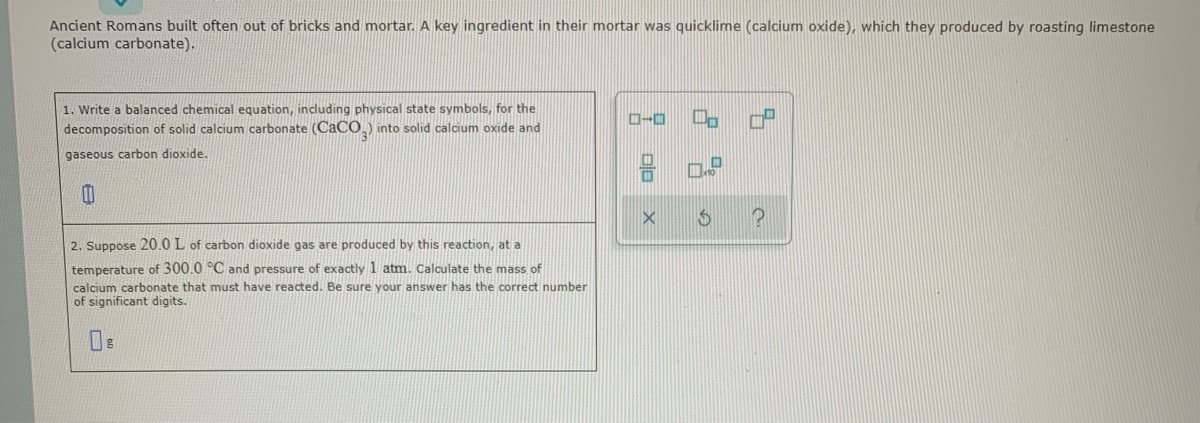Ancient Romans built often out of bricks and mortar. A key ingredient in their mortar was quicklime (calcium oxide), which they produced by roasting limestone (calcium carbonate). 1. Write a balanced chemical equation, including physical state symbols, for the decomposition of solid calcium carbonate (CaCO,) into solid calcium oxide and D-0 gaseous carbon dioxide. 2. Suppose 20.0 L of carbon dioxide gas are produced by this reaction, at a temperature of 300.0 °C and pressure of exactly 1 atm. Calculate the mass of calcium carbonate that must have reacted. Be sure your answer has the correct number of significant digits. olo
Ancient Romans built often out of bricks and mortar. A key ingredient in their mortar was quicklime (calcium oxide), which they produced by roasting limestone (calcium carbonate). 1. Write a balanced chemical equation, including physical state symbols, for the decomposition of solid calcium carbonate (CaCO,) into solid calcium oxide and D-0 gaseous carbon dioxide. 2. Suppose 20.0 L of carbon dioxide gas are produced by this reaction, at a temperature of 300.0 °C and pressure of exactly 1 atm. Calculate the mass of calcium carbonate that must have reacted. Be sure your answer has the correct number of significant digits. olo
Introductory Chemistry: A Foundation
9th Edition
ISBN:9781337399425
Author:Steven S. Zumdahl, Donald J. DeCoste
Publisher:Steven S. Zumdahl, Donald J. DeCoste
Chapter9: Chemical Quantities
Section: Chapter Questions
Problem 100CP: he production capacity for acrylonitrile (C3H3N)in the United States is over 2 billion pounds per...
Related questions
Question

Transcribed Image Text:Ancient Romans built often out of bricks and mortar. A key ingredient in their mortar was quicklime (calcium oxide), which they produced by roasting limestone
(calcium carbonate).
1. Write a balanced chemical equation, including physical state symbols, for the
decomposition of solid calcium carbonate (CaCO,) into solid calcium oxide and
gaseous carbon dioxide.
2. Suppose 20.0 L of carbon dioxide gas are produced by this reaction, at a
temperature of 300.0 °C and pressure of exactly 1 atm. Calculate the mass of
calcium carbonate that must have reacted. Be sure your answer has the correct number
of significant digits.
Expert Solution
This question has been solved!
Explore an expertly crafted, step-by-step solution for a thorough understanding of key concepts.
This is a popular solution!
Trending now
This is a popular solution!
Step by step
Solved in 2 steps with 1 images

Knowledge Booster
Learn more about
Need a deep-dive on the concept behind this application? Look no further. Learn more about this topic, chemistry and related others by exploring similar questions and additional content below.Recommended textbooks for you

Introductory Chemistry: A Foundation
Chemistry
ISBN:
9781337399425
Author:
Steven S. Zumdahl, Donald J. DeCoste
Publisher:
Cengage Learning


Chemistry: An Atoms First Approach
Chemistry
ISBN:
9781305079243
Author:
Steven S. Zumdahl, Susan A. Zumdahl
Publisher:
Cengage Learning

Introductory Chemistry: A Foundation
Chemistry
ISBN:
9781337399425
Author:
Steven S. Zumdahl, Donald J. DeCoste
Publisher:
Cengage Learning


Chemistry: An Atoms First Approach
Chemistry
ISBN:
9781305079243
Author:
Steven S. Zumdahl, Susan A. Zumdahl
Publisher:
Cengage Learning

Chemistry
Chemistry
ISBN:
9781305957404
Author:
Steven S. Zumdahl, Susan A. Zumdahl, Donald J. DeCoste
Publisher:
Cengage Learning

Chemistry & Chemical Reactivity
Chemistry
ISBN:
9781337399074
Author:
John C. Kotz, Paul M. Treichel, John Townsend, David Treichel
Publisher:
Cengage Learning

Chemistry & Chemical Reactivity
Chemistry
ISBN:
9781133949640
Author:
John C. Kotz, Paul M. Treichel, John Townsend, David Treichel
Publisher:
Cengage Learning